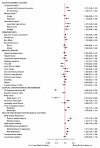Health care insurance, financial concerns in accessing care, and delays to hospital presentation in acute myocardial infarction
- PMID: 20388895
- PMCID: PMC3020978
- DOI: 10.1001/jama.2010.409
Health care insurance, financial concerns in accessing care, and delays to hospital presentation in acute myocardial infarction
Abstract
Context: Little is known about how health insurance status affects decisions to seek care during emergency medical conditions such as acute myocardial infarction (AMI).
Objective: To examine the association between lack of health insurance and financial concerns about accessing care among those with health insurance, and the time from symptom onset to hospital presentation (prehospital delays) during AMI.
Design, setting, and patients: Multicenter, prospective study using a registry of 3721 AMI patients enrolled between April 11, 2005, and December 31, 2008, at 24 US hospitals. Health insurance status was categorized as insured without financial concerns, insured but have financial concerns about accessing care, and uninsured. Insurance information was determined from medical records while financial concerns among those with health insurance were determined from structured interviews.
Main outcome measure: Prehospital delay times (< or = 2 hours, > 2-6 hours, or > 6 hours), adjusted for demographic, clinical, and social and psychological factors using hierarchical ordinal regression models.
Results: Of 3721 patients, 2294 were insured without financial concerns (61.7%), 689 were insured but had financial concerns about accessing care (18.5%), and 738 were uninsured (19.8%). Uninsured and insured patients with financial concerns were more likely to delay seeking care during AMI and had prehospital delays of greater than 6 hours among 48.6% of uninsured patients and 44.6% of insured patients with financial concerns compared with only 39.3% of insured patients without financial concerns. Prehospital delays of less than 2 hours during AMI occurred among 36.6% of those insured without financial concerns compared with 33.5% of insured patients with financial concerns and 27.5% of uninsured patients (P < .001). After adjusting for potential confounders, prehospital delays were associated with insured patients with financial concerns (adjusted odds ratio, 1.21 [95% confidence interval, 1.05-1.41]; P = .01) and with uninsured patients (adjusted odds ratio, 1.38 [95% confidence interval, 1.17-1.63]; P < .001).
Conclusion: Lack of health insurance and financial concerns about accessing care among those with health insurance were each associated with delays in seeking emergency care for AMI.
Figures


Comment in
-
Insurance and financial concerns among patients seeking care for acute myocardial infarction.JAMA. 2010 Aug 4;304(5):523; author reply 523-4. doi: 10.1001/jama.2010.1070. JAMA. 2010. PMID: 20682929 No abstract available.
References
-
- Kaiser Commission on Medicaid and the Uninsured The Uninsured: A Primer. [Accessed February 3, 2010]. Jan2006. at http://www.kff.org/uninsured/7451.cfm.
-
- Gabel JR, McDevitt R, Lore R, Pickreign J, Whitmore H, Ding T. Trends in underinsurance and the affordability of employer coverage, 2004-2007. Health Aff (Millwood) 2009;28:w595–606. - PubMed
-
- Ayanian JZ, Weissman JS, Schneider EC, Ginsburg JA, Zaslavsky AM. Unmet health needs of uninsured adults in the United States. JAMA. 2000;284:2061–9. - PubMed
-
- Ross JS, Bradley EH, Busch SH. Use of health care services by lower-income and higher-income uninsured adults. JAMA. 2006;295:2027–36. - PubMed
-
- EMTALA Emergency Medical Treatment and Labor Act of 1986. Public Law. pp. 99–272.
Publication types
MeSH terms
Grants and funding
LinkOut - more resources
Full Text Sources
Medical
Miscellaneous

